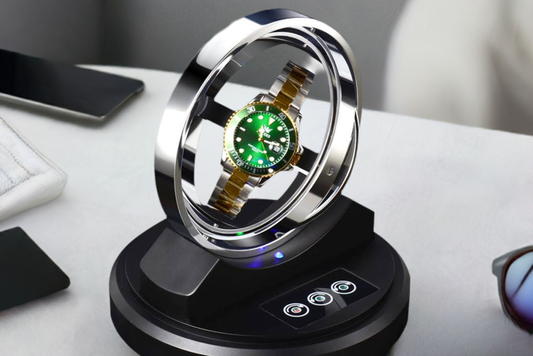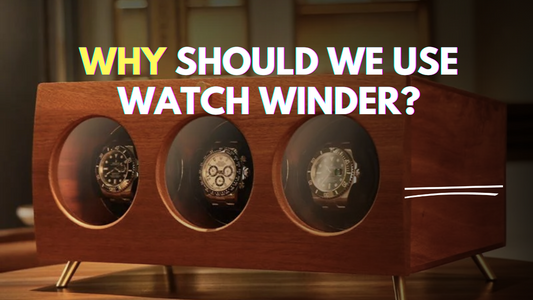How long do self-winding watches last?
Self-winding watches, also known as automatic watches, can last for decades or even generations with proper care and maintenance. As Patek Philippe's advertising slogan describes: You never actually own a Patek Philippe, you merely look after it for the next generation. The longevity of a self-winding watch depends on factors such as the quality of craftsmanship, materials used, and regular servicing.
Credit: YouTube Channel - He Spoke Style
How to keep a self-winding watch running?
To keep a self-winding watch running, wear it regularly to allow the natural movement of your wrist to wind the watch's mainspring. Extended periods of inactivity can pose various risks to automatic watches, including lubrication issues leading to increased friction, mainspring tension loss affecting accuracy, potential corrosion and wear due to dust and moisture accumulation, timekeeping inaccuracies, and movement damage such as seizing or sluggishness. If you're not wearing the watch daily, consider using a watch winder to keep it running when not in use.
Do you have to wind an automatic watch?
Automatic watches do not necessarily need to be manually wound if worn regularly. However, if the watch has stopped or has not been worn for some time, manual winding may be required to restart the movement.
How to wind an automatic watch?
To wind an automatic watch manually, gently rotate the crown clockwise until you feel resistance. Avoid over-winding by stopping once you feel resistance. If the watch is a screw-down crown, unscrew it first before winding.
How often do you need to wind a watch?
The frequency of winding depends on how often the watch is worn. If worn daily, the natural motion of the wrist should keep the watch wound. For watches not worn regularly, winding every few days or once a week may be necessary to maintain power reserve. If you are using a watch winder, please ensure that the automatic mechanical watch is fully charged before use. You can manually wind it or gently shake it sixty to seventy times until it has more than half of its kinetic energy. After calibrating the time, carefully place it into the watch winder for optimal performance.
Can you over-wind an automatic watch?
Modern automatic watches are designed with mechanisms to prevent over-winding, so it's unlikely to damage the watch by winding it manually. However, it's essential to avoid excessive force when winding to prevent potential damage.
What does a watch winder do?
A watch winder is a device designed to mimic the motion of the wrist to keep automatic watches running when not being worn. It rotates the watch in a controlled manner, preventing the mainspring from unwinding and ensuring the watch remains accurate.
Is it bad to wind an automatic watch?
Winding an automatic watch manually is not inherently bad, but it's essential to do it gently and avoid over-winding. Following the manufacturer's recommendations for winding frequency and technique is advisable to prevent potential damage.
Do I need a watch winder?
A watch winder is not essential but can be beneficial for automatic watch owners who have multiple watches in their collection or don't wear them regularly. It helps keep watches wound and ready to wear while preventing the need for manual winding each time.
Why use a watch winder?
A watch winder ensures that automatic watches remain wound and running accurately when not in use. It also prevents the need for manual winding, reduces wear on internal components, and preserves the longevity of the watch. Read More.
What is a good watch winder?
A good watch winder should be durable, quiet, and capable of rotating watches in both clockwise and counterclockwise directions. It should also offer adjustable settings to accommodate different watch models and winding requirements. Our URORO watch winder is equipped with LED light, fingerprint lock, LCD screen, 3 models of rotations etc., meeting the winding needs of Rolex, Omega and other watch brands and models.
Is it worth getting a watch winder?
The value of a watch winder depends on personal preferences and the number of automatic watches owned. For collectors with multiple watches or those who don't wear them regularly, a watch winder can be a convenient and practical investment.
How to set a watch winder?
Setting a watch winder involves adjusting the rotation direction, turns per day (TPD), and winding intervals according to the specifications of the watch being wound. Refer to the watch manufacturer's recommendations for the optimal settings.
Which direction to wind a watch? What is the recommended setting: clockwise, counterclockwise, or alternating?
The recommended winding direction depends on the watch movement. Some watches wind in one direction (unidirectional), while others wind bidirectionally (clockwise and counterclockwise). Alternating settings are suitable for watches with bidirectional winding mechanisms.
How many rotations to wind automatic watch?
The number of rotations required to wind an automatic watch varies depending on the watch's power reserve and winding mechanism. Typically, 30 to 40 rotations are sufficient to fully wind most automatic watches.
Are the watch winder motors silent?
The noise level of a watch winder relies on its internal motors' performance and quality. Most watch winder brands opt for Mabuchi motors due to their smooth winding and relatively quiet operation, typically emitting less than 10 decibels. While others opt for Elma motors, although pricier, excel in noise reduction and longevity, making them ideal for noise-sensitive individuals. However, for those on a budget, a Mabuchi motor watch winder remains a practical choice.
Would it be possible to wind all automatic watches using URORO watch winding box?
Most automatic watches can be wound using URORO watch winding box that offer adjustable settings for rotation direction, TPD, and winding intervals. However, it's essential to ensure compatibility with specific watch models and movement types.
What’s the difference between AC and DC powered watch winders?
The main difference between AC (alternating current) and DC (direct current) powered watch winders is the type of power source they use. AC-powered winders require a standard electrical outlet, while DC-powered winders can be powered by batteries or rechargeable power sources, offering greater flexibility in placement and portability.




